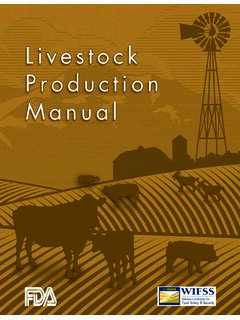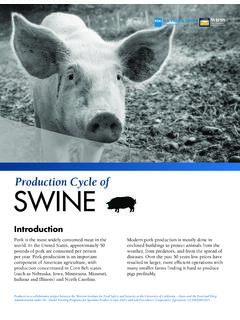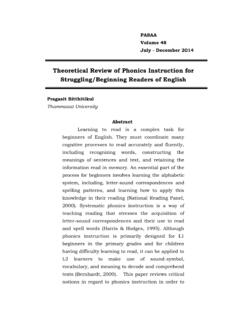Transcription of TOMATOES - UC Davis Western Institute for Food Safety and ...
1 Presented byTOMATOESTOMATOESThis production summary provides an overview of growing, harvesting, and post harvesting practices. There are some common practices that many large commercial growers use when producing TOMATOES , and though there are variations in these practices, having an understanding of the most common methods used will be helpful when carrying out regulatory activities. By the end of this summary, you will be able to:1. List examples of commercially produced varieties of List the top producing regions in the for fresh market TOMATOES . 3. Identify common farming practices used in the production of fresh market TOMATOES . 4. Describe farming practices used in different tomato growing are approximately 7,500 tomato varieties grown for various purposes. Tomato varieties can be divided into several categories, mostly based on shape and size:1. Slicing or globe, also known as round TOMATOES , are used in processing or fresh Beefsteak are large TOMATOES often used for Plum TOMATOES are bred for higher solids for use in tomato sauce and Cherry TOMATOES are small, round, often sweet, and used whole in Grape TOMATOES , a more recent variety, are a smaller variation of a plum tomato primarily used in varieties are classified as determinate or indeterminate.
2 Determinate or bush types bear a full crop all at once and top off at a specific height. They are preferred by commercial growers who wish to harvest a whole field at one time. Indeterminate varieties develop into vines that, under favorable growing conditions, never top off and continue to produce fruit until cold weather sets in. They are preferred by commercial fresh market growers and home growers who want ripe fruit throughout a growing the , cultivation of tomato varieties is usually determined by their final destination or usage. For example, will they be consumed in fresh form by consumers or used in processing by manufacturers of tomato products?Production practices differ between fresh market and processing TOMATOES . For the purposes of this summary, we will focus on production practices for fresh market 2 TOMATOES TOMATOES . Though there are other countries that produce significant quantities of TOMATOES , in this summary, we will focus on the production practices common in the Fresh market TOMATOES are produced in every state in the , with commercial-scale production in about 20 states.
3 Florida and California produce the majority of all commercially grown fresh market TOMATOES in the nearly 30 million pounds each year! Florida ranks first in the production of fresh market TOMATOES . Principal tomato production regions are located in south Florida, central Florida (south of Tampa), and a small production region in northwest Florida. California is a close second in fresh market tomato production and contributes significantly to the crop of fresh market TOMATOES produced in the TOMATOES are grown in nearly every county in California, but the majority of fresh market TOMATOES are grown in the Central Valley and along the southern significant fresh market producing states are Virginia, Georgia, Ohio, Tennessee, North and South Carolina, New Jersey, and Michigan (Fig 1). GROWINGF resh market TOMATOES are available year-round due to the overlapping seasons of Florida, California, and the other production states. Imports from Mexico and the Canadian greenhouse industry also contribute to the availability of fresh TOMATOES during winter months when domestic production is at its lowest.
4 During the winter months, Florida TOMATOES are primarily shipped to states in the eastern , and imported Mexican TOMATOES account for most of the TOMATOES marketed in the west. TOMATOES are a warm-season crop that is sensitive to frost at any growth stage. Daily maximum air temperature between 77 and 95 F is ideal for plant growth. With adequate soil moisture, tomato plants can tolerate temperatures well in excess of 100 F, although extremely hot temperatures can adversely affect the developing grow well in a variety of soil textures, but commercial growers tend to prefer the sandy soils found in most Florida growing regions and the coastal growing regions in California. Sandy soils drain better and warm up more readily than denser soils. Denser soils like loam and clay loam may also be used as long as the fields are carefully irrigated and well drained. Dense soil textures are more common in the central valley growing regions in California. Universally, all soil is prepared prior to planting using a variety of specialty equipment to improve the overall quality of the soil by breaking up clods and adding amendments.
5 Following soil preparation, uniform and parallel raised beds are formed and, most likely, a drip irrigation system is installed. Raised beds are typically covered with a thick plastic. young tomato plants, sprouted in greenhouses, are transplanted to the fields by hand or with the use of specialized mechanical equipment. Most fresh market TOMATOES , like those grown in Florida and in some areas of California, are grown with a support system such as a metal pole or wooden stake. This support system allows for a higher quality product by keeping the fruit off the ground, increases yield, and allows harvest crews to enter the field for multiple picks without jeopardizing the integrity of the the warm summer months, open planting is the norm. In cooler times, growers may use plastic row covers to protect growing tomato plants from frost. Hoop or tunnel houses are used to extend the growing season earlier into the spring and later into fall. These structures are relatively simple polyethylene-covered unheated structures that typically do not use fans or 1 - Top Tomato Producing States in the US 3 TOMATOESThe type of irrigation used in tomato fields depends on the water resources in a growing area.
6 In some regions of Florida, where water is plentiful, furrow or seepage irrigation is used. In California, where water is scarce, drip irrigation is used exclusively because of the efficient use of water. Regardless of region, overhead sprinklers are routinely used to help establish new tomato growers use chemical fertilizers or properly composted organic materials to provide nutrients to growing plants. Fertilizers are applied before transplants are planted, side dressed in furrow irrigation systems, or applied through drip irrigation. The term chemigation is the injection of any chemical such as nitrogen, phosphorus, or a pesticide into irrigation water and applied to the land using the irrigation and insects are a problem for fresh market tomato growers. Several commercial herbicides and pesticides are available for use on and around developing and mature tomato plants. Most chemicals are applied with tractors fitted with sprayers. Tomato plants are susceptible to several fungal and bacterial diseases.
7 Growers carefully manage irrigation of the fields to avoid over-watering, and may select tomato varieties that are resistant to plant pathogens. Chemical sprays are often used to control these diseases and fungicides are usually applied after a and bait stations are used to control rodents in tomato fields. Fencing and perimeter controls can be used to reduce field ingress of feral animals. Animal intrusion is often seen in tomato fields, especially raccoons, deer, and feral pigs. Fields are monitored prior to harvest for evidence of droppings in furrows, and when excessive, cleaned-up to prevent contamination of fruit during market TOMATOES are harvested by hand. Harvesting periods may last up to 120 days. The USDA defines six stages of exterior color to gauge the ripeness of TOMATOES . Fresh market TOMATOES are hand-harvested in the green, breaker, or turning stages. Green TOMATOES are picked into buckets then dumped into bins or gondolas for transport from the field to the packinghouse.
8 Fresh market TOMATOES can be harvested in the pink stage and marketed as vine ripened TOMATOES . In this instance vine ripened pink TOMATOES are harvested by hand into lug boxes and are transported to the packinghouse. Harvesting of vine ripened TOMATOES is done frequently to avoid over ripening. Some growers allow contract field packing of ripe TOMATOES . In Florida, a state law was enacted covering tomato harvesting, which requires field packed TOMATOES to undergo a washing process prior to majority of fresh market TOMATOES arrive at the shed in bulk bins or in a gondola truck. TOMATOES are mechanically unloaded into a treated water dump tank. Most of the plant material carried in on TOMATOES is separated at this stage. Water jets convey the fruit by flumes to a conveyor belt system, where they are rinsed, then cleaned with soft bristle brushes that remove any remaining field debris. Water used in dump tanks and flumes should be 10 degrees higher than the internal temperature of the TOMATOES to prevent water from being internalized through temperature gradients.
9 In addition, a 4 TOMATOES high level of chlorine is maintained in the water to prevent transfer of pathogens from one tomato to another. After washing, the fruit is dried, waxed, pre-graded, and sorted by color, size, and grade, and packed into cartons. Vine ripened TOMATOES are sent to a separate packing line that operates at a lower speed for gentler handling. Manual sorting of TOMATOES for defects, color, and size is done at this preserves the quality of the fruit. Following packing, TOMATOES are typically stored and stacked in cooled warehouses at 50 F. Green TOMATOES may be cooled and stored for up to two weeks before ripening. During holding, green TOMATOES are ripened at temperatures between 57 and 70 F, and are frequently exposed to ethylene oxide gas treatment for 24 to 48 hours to ensure uniform color development prior to a basic understanding of the way fresh market TOMATOES are grown, harvested, cooled, and prepared for market will provide the basic background information that will be helpful to regulators when completing inspections or investigations in the agricultural practices described in this production summary are common on most large commercial farms like those found in major tomato producing regions in the United States.
10 There are undoubtedly variations in these practices depending on the region, operation size, and individual grower preferences. This is especially true of farms outside of the 5 TOMATOESREFERENCESB ielinski Santos, Eugene McAvoy, Monica Ozores-Hampton, Gary Vallad, Peter Dittmar, Susan Webb, Hugh Smith, Stephen Olson. Chapter 12. Tomato Production. IFAS Extension University of Florida. IFAS Extension, 2013. Web. 26 Aug. Hochmuth, R. Hochmuth. Production of Greenhouse TOMATOES Florida Greenhouse Vegetable Production Handbook, Vol 3. EDIS. University of Florida IFAS Extension, 1990. Web. 26 Aug. 2014. Harvesting Schedule. Florida TOMATOES . Florida Tomato Committee, 2011. Web. 26 Aug. Boriss, Henrich Brunke. Fresh TOMATOES Profile. Agricultural Marketing Resource Center. AgMRC, 2005. Web. 26 Aug. 2014. High Tunnel TOMATOES . Cooperative Extension Service. University of Kentucky - College of Agriculture, 2012. Web. 26 Aug. Lestrange, Wayne Schrader, Timothy Hartz.




